The Fixed Cranes Market is estimated to be valued at USD 8.7 billion in 2025 and is projected to reach USD 15.5 billion by 2035, registering a compound annual growth rate (CAGR) of 6.0% over the forecast period. In the years leading up to 2025, the market experiences gradual growth, rising from USD 6.5 billion in 2020 to USD 8.7 billion, indicating early adoption of modern crane solutions in emerging economies and expanding industrial hubs. By 2025, increased urbanization and industrialization will drive significant demand, marking the start of a scaling phase.
From 2025 to 2030, the market growth accelerates moderately, with values increasing from USD 8.7 billion to approximately USD 10.9 billion, as large-scale construction projects and port modernization initiatives boost crane deployment. Year-on-year, the market observes consistent expansion of 5–7%, driven by the replacement of aging equipment and the adoption of advanced fixed crane models with higher efficiency and load capacity. Between 2030 and 2035, the market enters a consolidation phase, expanding from USD 11.6 billion in 2030 to USD 15.5 billion in 2035. Growth during this period is supported by technological advancements, automation integration, and increased safety standards, though competitive pressures and market saturation slightly temper the pace. Overall, the fixed cranes market shows a balanced trajectory of steady adoption, scaling, and consolidation over the 2020–2035 horizon.
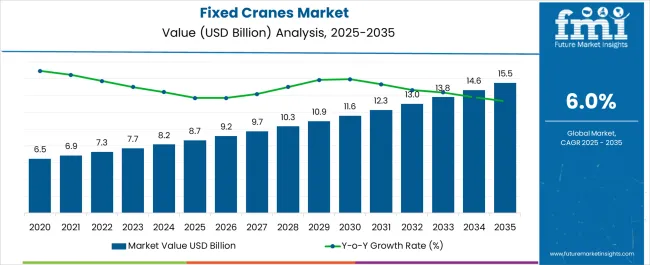
| Metric | Value |
|---|---|
| Fixed Cranes Market Estimated Value in (2025 E) | USD 8.7 billion |
| Fixed Cranes Market Forecast Value in (2035 F) | USD 15.5 billion |
| Forecast CAGR (2025 to 2035) | 6.0% |
The fixed cranes market is experiencing consistent growth due to rising infrastructure development, urbanization, and increased investments in commercial and industrial construction across emerging and developed economies. The demand for high-capacity and stable lifting solutions has made fixed cranes essential in large-scale projects, particularly where mobility is less critical but load stability and height reach are vital.
Technological advancements in automation, remote monitoring, and precision control have improved operational efficiency and safety. Additionally, the integration of modular designs and energy-efficient components is enhancing lifecycle value.
As governments and private entities continue to invest in housing, transport, and industrial expansion, the fixed cranes market is expected to maintain upward momentum driven by both capacity expansion and replacement demand.
The fixed cranes market is segmented by product, load capacity, application, technology reach, and geographic regions. By product, the fixed cranes market is divided into Tower cranes, Gantry cranes, Stiffleg cranes, and Monorail cranes. In terms of load capacity, the fixed cranes market is classified into below 25 Ton, 26 Ton to 50 Ton, 51 Ton to 80 Ton, and above 80 Ton.
Based on application, the fixed cranes market is segmented into construction and mining, oil and gas, transportation and shipping, Manufacturing, and Utility. By technology, the fixed cranes market is segmented into Manual, Semi-automatic, and Fully automatic. By reach, the fixed cranes market is segmented into Low height (up to 30 meters), Medium height (30-60 meters), and High height (more than 60 meters). Regionally, the fixed cranes industry is classified into North America, Latin America, Western Europe, Eastern Europe, Balkan & Baltic Countries, Russia & Belarus, Central Asia, East Asia, South Asia & Pacific, and the Middle East & Africa.
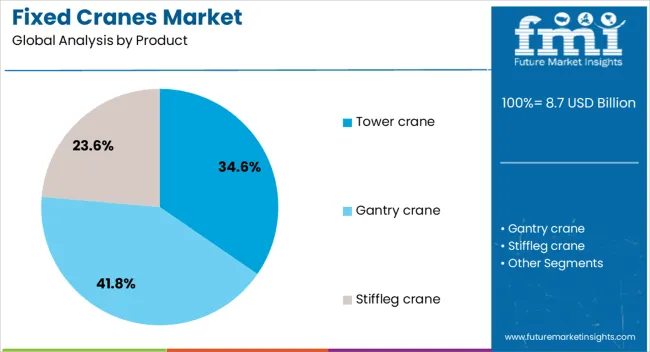
The tower crane segment is expected to hold 34.60% of the total market revenue by 2025 within the product category, positioning it as the leading product segment. This growth is attributed to the segment’s critical role in high-rise construction and large-scale infrastructure projects.
Tower cranes provide superior height and lifting capacity, making them indispensable for vertical construction and heavy material handling. Their stationary configuration ensures better load stability and extended reach, which are essential for safe and efficient operations in dense urban construction environments.
The ability to operate in limited ground space while offering wide working radii has further reinforced their utility. These factors collectively support the continued dominance of tower cranes in the product category.
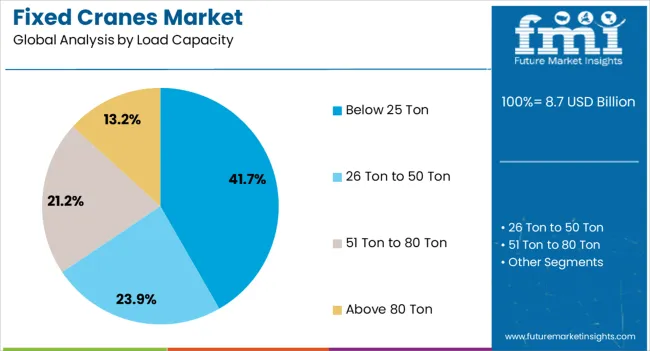
The below 25-ton load capacity segment is projected to contribute 41.70% of the total market revenue by 2025, establishing itself as the most utilized capacity range. This is driven by its suitability for mid-scale construction activities, particularly in urban areas where space constraints and building regulations limit the use of ultra-heavy machinery.
These cranes offer a practical balance between lifting strength, operational flexibility, and cost efficiency. Their ease of installation and maintenance make them an attractive choice for contractors and developers working on residential and commercial buildings.
As infrastructure projects diversify in scope and size, the demand for versatile cranes within this load bracket remains strong.
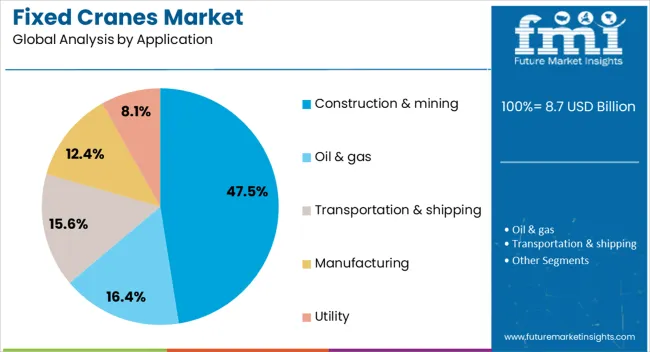
The construction and mining segment is expected to account for 47.50% of the total market revenue by 2025, making it the most prominent application area. This growth is driven by a surge in construction projects globally, especially in emerging economies where governments are focused on improving urban infrastructure and connectivity.
Fixed cranes are increasingly deployed in both surface and underground mining operations for equipment handling, material lifting, and structural assembly. Their stability and lifting precision contribute to operational efficiency and worker safety, both critical in high-risk environments.
As construction and mining activities expand to meet global demand for housing, transportation, and raw materials, this segment continues to anchor the overall market growth.
The fixed cranes market is witnessing steady growth due to increasing construction, industrial, and port infrastructure activities. Fixed cranes, including tower cranes, gantry cranes, and jib cranes, are essential for heavy lifting and material handling in construction sites, warehouses, and shipyards. Rising urbanization, industrial expansion, and port modernization projects drive demand globally. Europe and North America lead due to stringent safety standards and infrastructure investments, while Asia-Pacific shows rapid growth with large-scale construction projects. Market trends focus on automation, enhanced load capacity, and energy-efficient designs. Innovations in IoT-enabled monitoring, remote operation, and modular construction further enhance operational efficiency and safety.
Fixed cranes involve significant upfront capital investment for purchase, installation, and foundation work, limiting adoption among small-scale operators. Maintenance requirements, including periodic inspections, lubrication, and structural assessments, add ongoing operational costs. Site-specific installation challenges, such as space constraints or soil stability, can further increase costs. Until cost-effective modular designs and maintenance solutions become more widespread, high investment and upkeep expenses will remain a barrier, particularly for emerging markets and small construction firms seeking efficient lifting solutions.
Advancements in fixed crane technology are improving efficiency, safety, and productivity. Automated features, remote control systems, IoT-enabled monitoring, and predictive maintenance help operators optimize load handling and reduce downtime. High-capacity cranes with enhanced load stability and energy-efficient motors support large construction and industrial projects. Smart sensors, anti-collision systems, and telematics integration enhance operational safety and minimize human error. Manufacturers investing in R&D for automation, modularity, and real-time monitoring solutions are creating competitive advantages while enabling adoption in complex and high-risk construction environments.
The fixed crane market is heavily influenced by safety regulations and compliance standards. Organizations must adhere to international standards such as ISO 4301, ISO 9927, and local workplace safety laws to ensure structural integrity, operator safety, and proper load handling. Non-compliance risks accidents, penalties, and project delays. Regulatory requirements also impact installation, operation, and maintenance procedures, requiring skilled personnel and certified inspections. Companies aligning with global safety standards and offering operator training programs enhance credibility and adoption, particularly in high-risk industrial and port operations where compliance is strictly monitored.
The fixed crane market is competitive, with established players offering a range of high-capacity and specialized solutions. Smaller or local manufacturers may compete on price but often lack advanced automation and safety features. Supply chain challenges, including sourcing steel, motors, and electronic components, affect production timelines and cost structures. Companies investing in vertical integration, regional manufacturing facilities, and strategic partnerships with construction and port operators gain reliability and market access. Competitive differentiation increasingly focuses on load capacity, automation, energy efficiency, and safety innovations to capture industrial, commercial, and infrastructure-related projects globally.

| Countries | CAGR |
|---|---|
| China | 8.1% |
| India | 7.5% |
| Germany | 6.9% |
| France | 6.3% |
| UK | 5.7% |
| USA | 5.1% |
| Brazil | 4.5% |
The global Fixed Cranes Market is projected to grow at a CAGR of 6.0% through 2035, supported by increasing demand across construction, logistics, and industrial handling applications. Among BRICS nations, China has been recorded with 8.1% growth, driven by large-scale production and deployment in infrastructure and industrial projects, while India has been observed at 7.5%, supported by rising utilization in construction and material handling operations. In the OECD region, Germany has been measured at 6.9%, where production and adoption for industrial, construction, and logistics purposes have been steadily maintained. The United Kingdom has been noted at 5.7%, reflecting consistent use in construction and industrial operations, while the USA has been recorded at 5.1%, with production and utilization across construction, logistics, and industrial sectors being steadily increased. This report includes insights on 40+ countries; the top five markets are shown here for reference.
The fixed cranes market in China is growing at a CAGR of 8.1%, driven by the expansion of construction, infrastructure, and industrial projects. Rapid urbanization, large-scale construction of residential and commercial buildings, and government-led infrastructure initiatives are creating consistent demand for fixed cranes. The market benefits from technological innovations such as high-load capacity cranes, enhanced safety features, and automation for precision handling. Industrial sectors including steel, ports, and logistics increasingly rely on fixed cranes for material handling and efficient workflow management. Government investments in smart cities, bridges, and transportation hubs further fuel market expansion. China’s strong manufacturing base for crane components also enables domestic production and cost-effective deployment, enhancing adoption across industries.
The fixed cranes market in India is expanding at a CAGR of 7.5%, supported by rapid infrastructure development and industrial growth. Rising construction activity in urban areas, highways, ports, and industrial facilities drives demand for fixed cranes. Technological advancements in load capacity, safety systems, and automation improve operational efficiency, reliability, and safety in material handling. Government programs such as Smart Cities Mission, industrial corridor development, and port modernization projects boost market growth. Industrial sectors including steel, cement, and logistics are increasingly deploying fixed cranes for heavy-lifting and precise material placement. The growing manufacturing sector and construction boom, coupled with increasing foreign investments in infrastructure, ensure steady market adoption of fixed cranes across India.

Germany’s fixed cranes market is growing at a CAGR of 6.9%, driven by industrial automation, construction projects, and logistics requirements. Fixed cranes are widely used in manufacturing, steel plants, ports, and construction sites for material handling, lifting, and precise positioning. Technological improvements in crane design, load capacity, safety features, and automation enhance efficiency and workplace safety. Germany’s focus on industrial modernization, smart factories, and infrastructure upgrades supports market demand. Additionally, regulatory standards for safety and environmental compliance encourage the adoption of advanced crane systems. The combination of strong industrial infrastructure and ongoing modernization projects ensures steady growth of fixed cranes in Germany.
The fixed cranes market in the United Kingdom is expanding at a CAGR of 5.7%, fueled by construction, industrial, and port development projects. Urban infrastructure projects, commercial buildings, and industrial facilities drive demand for fixed cranes. Technological enhancements, such as higher load capacity, improved safety, and automation, increase operational efficiency and safety. The UK government’s infrastructure development plans, including transport, housing, and smart city projects, further support market growth. Industrial sectors, including manufacturing and logistics, increasingly rely on fixed cranes for material handling and precision operations. With steady demand from both construction and industrial applications, the UK fixed cranes market is expected to maintain consistent growth in the coming years.
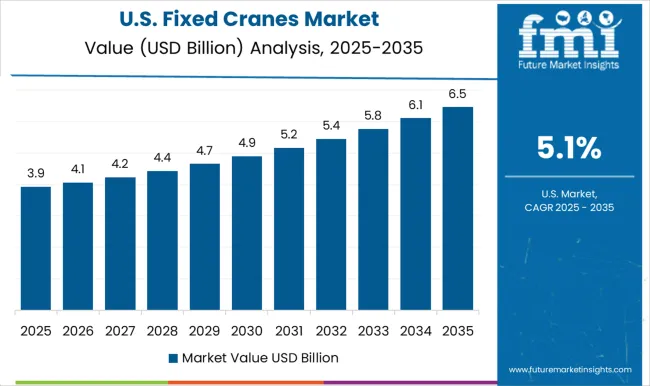
The fixed cranes market in the United States is growing at a CAGR of 5.1%, driven by construction, industrial, and logistics requirements. Fixed cranes are extensively deployed in manufacturing, ports, warehouses, and infrastructure projects for material handling, lifting, and precise operations. Technological developments, including higher load capacity, automation, and advanced safety systems, enhance operational efficiency and workplace safety. The USA government’s focus on infrastructure development, industrial modernization, and smart factories supports market growth. Industrial sectors, including steel, automotive, and logistics, increasingly adopt fixed cranes to optimize workflows and reduce labor dependency. Rising investments in infrastructure and industrial projects are expected to sustain steady growth for fixed cranes across the United States.
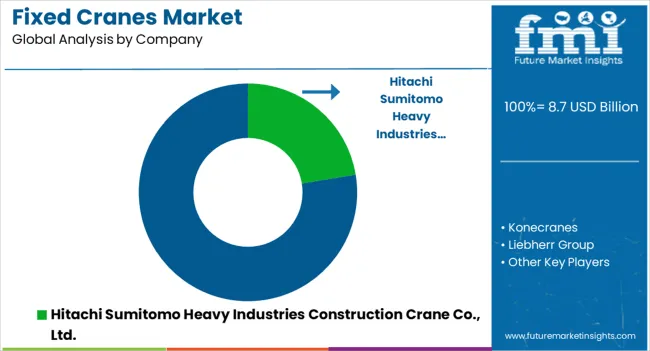
The fixed cranes market plays a crucial role in construction, heavy industry, and port operations, providing reliable lifting solutions for large-scale projects. These cranes are designed for high load capacities and long-term operational efficiency, making them indispensable for infrastructure development, shipbuilding, and material handling. Rising urbanization, industrial expansion, and infrastructure investments are driving the demand for advanced fixed cranes globally. Hitachi Sumitomo Heavy Industries Construction Crane Co., Ltd. is a prominent player, offering a range of tower and construction cranes known for durability and advanced control systems. Konecranes specializes in industrial lifting solutions, including fixed cranes for ports and factories, with a strong focus on automation and safety. Liebherr Group provides high-performance fixed cranes for construction and maritime applications, emphasizing precision, energy efficiency, and long service life. Manitowoc Company delivers reliable tower cranes and crawler cranes designed for construction projects worldwide, while Sany Heavy Industry Co., Ltd. offers competitively priced, robust cranes suitable for both domestic and international markets.
Sumitomo Heavy Industries, Ltd. manufactures a wide array of fixed cranes, combining Japanese engineering with innovative technology for heavy-lifting applications. Tadano Ltd. focuses on mobile and fixed cranes with advanced hydraulics and safety features. Terex Corporation produces fixed cranes optimized for construction and industrial sectors, whereas XCMG Construction Machinery Co., Ltd. and Zoomlion Heavy Industry Science & Technology Co., Ltd. supply high-quality cranes catering to large-scale infrastructure projects, especially in emerging markets.
| Item | Value |
|---|---|
| Quantitative Units | USD 8.7 Billion |
| Product | Tower crane, Gantry crane, Stiffleg crane, and Monorail crane |
| Load Capacity | Below 25 Ton, 26 Ton to 50 Ton, 51 Ton to 80 Ton, and Above 80 Ton |
| Application | Construction & mining, Oil & gas, Transportation & shipping, Manufacturing, and Utility |
| Technology | Manual, Semi-automatic, and Fully automatic |
| Reach | Low height (up to 30 meters), Medium height (30-60 meters), and High height (more than 60 meters) |
| Regions Covered | North America, Europe, Asia-Pacific, Latin America, Middle East & Africa |
| Country Covered | United States, Canada, Germany, France, United Kingdom, China, Japan, India, Brazil, South Africa |
| Key Companies Profiled | Hitachi Sumitomo Heavy Industries Construction Crane Co., Ltd., Konecranes, Liebherr Group, Manitowoc Company, Sany Heavy Industry Co., Ltd., Sumitomo Heavy Industries, Ltd., Tadano Ltd., Terex Corporation, XCMG Construction Machinery Co., Ltd., and Zoomlion Heavy Industry Science & Technology Co., Ltd. |
| Additional Attributes | Dollar sales vary by crane type, including tower cranes, overhead cranes, jib cranes, and monorail cranes; by technology, spanning manual, semi-automatic, and fully automated systems; by application, such as construction, manufacturing, mining, shipbuilding, power utilities, and ports; by region, led by Asia-Pacific, North America, and Europe. Growth is driven by rapid urbanization, infrastructure and industrial expansion, rising adoption of automation and IoT-enabled solutions, renewable energy projects, and enhanced safety and regulatory compliance. |
The global fixed cranes market is estimated to be valued at USD 8.7 billion in 2025.
The market size for the fixed cranes market is projected to reach USD 15.5 billion by 2035.
The fixed cranes market is expected to grow at a 6.0% CAGR between 2025 and 2035.
The key product types in fixed cranes market are tower crane, _below 25 ton, _26 ton to 50 ton, _51 ton to 80 ton, _above 80 ton, gantry crane, _below 25 ton, _26 ton to 50 ton, _51 ton to 80 ton, _above 80 ton, stiffleg crane, _below 25 ton, _26 ton to 50 ton, _51 ton to 80 ton, _above 80 ton, monorail crane, _below 25 ton, _26 ton to 50 ton, _51 ton to 80 ton and _above 80 ton.
In terms of load capacity, below 25 ton segment to command 41.7% share in the fixed cranes market in 2025.






Our Research Products

The "Full Research Suite" delivers actionable market intel, deep dives on markets or technologies, so clients act faster, cut risk, and unlock growth.

The Leaderboard benchmarks and ranks top vendors, classifying them as Established Leaders, Leading Challengers, or Disruptors & Challengers.

Locates where complements amplify value and substitutes erode it, forecasting net impact by horizon

We deliver granular, decision-grade intel: market sizing, 5-year forecasts, pricing, adoption, usage, revenue, and operational KPIs—plus competitor tracking, regulation, and value chains—across 60 countries broadly.

Spot the shifts before they hit your P&L. We track inflection points, adoption curves, pricing moves, and ecosystem plays to show where demand is heading, why it is changing, and what to do next across high-growth markets and disruptive tech

Real-time reads of user behavior. We track shifting priorities, perceptions of today’s and next-gen services, and provider experience, then pace how fast tech moves from trial to adoption, blending buyer, consumer, and channel inputs with social signals (#WhySwitch, #UX).

Partner with our analyst team to build a custom report designed around your business priorities. From analysing market trends to assessing competitors or crafting bespoke datasets, we tailor insights to your needs.
Supplier Intelligence
Discovery & Profiling
Capacity & Footprint
Performance & Risk
Compliance & Governance
Commercial Readiness
Who Supplies Whom
Scorecards & Shortlists
Playbooks & Docs
Category Intelligence
Definition & Scope
Demand & Use Cases
Cost Drivers
Market Structure
Supply Chain Map
Trade & Policy
Operating Norms
Deliverables
Buyer Intelligence
Account Basics
Spend & Scope
Procurement Model
Vendor Requirements
Terms & Policies
Entry Strategy
Pain Points & Triggers
Outputs
Pricing Analysis
Benchmarks
Trends
Should-Cost
Indexation
Landed Cost
Commercial Terms
Deliverables
Brand Analysis
Positioning & Value Prop
Share & Presence
Customer Evidence
Go-to-Market
Digital & Reputation
Compliance & Trust
KPIs & Gaps
Outputs
Full Research Suite comprises of:
Market outlook & trends analysis
Interviews & case studies
Strategic recommendations
Vendor profiles & capabilities analysis
5-year forecasts
8 regions and 60+ country-level data splits
Market segment data splits
12 months of continuous data updates
DELIVERED AS:
PDF EXCEL ONLINE
Fixed Length Seals Market Size and Share Forecast Outlook 2025 to 2035
Fixed 2D Industrial Barcode Scanner Market Size and Share Forecast Outlook 2025 to 2035
Fixed Business Voice Platforms And Services Market Size and Share Forecast Outlook 2025 to 2035
Fixed Shunt Reactor Market Size and Share Forecast Outlook 2025 to 2035
Fixed Cycle Regulator Residential Power Conditioner Market Size and Share Forecast Outlook 2025 to 2035
Fixed Wireless Access Market Size and Share Forecast Outlook 2025 to 2035
Fixed Offshore Wind Energy Market Size and Share Forecast Outlook 2025 to 2035
Fixed Series Compensation Market Size and Share Forecast Outlook 2025 to 2035
Fixed Asset Management Software Market Size and Share Forecast Outlook 2025 to 2035
Fixed Cutter Bits Market
5G Fixed Wireless Access Market
Mini Cranes Market Size and Share Forecast Outlook 2025 to 2035
Global Mini Cranes Market Share Analysis – Growth, Trends & Forecast 2025–2035
Marine Cranes Market Growth - Trends & Forecast 2025 to 2035
Spider Cranes Market Analysis based on Lifting Capacity, Operation, Control System, Application, Ownership and Region: A Forecast from 2025 to 2035
Lattice Cranes Market
Air Core Fixed Shunt Reactor Market Size and Share Forecast Outlook 2025 to 2035
GCC Mini Cranes Market Size and Share Forecast Outlook 2025 to 2035
Container Fixed Fittings Market Size and Share Forecast Outlook 2025 to 2035
Industrial Fixed Scanner Market Size and Share Forecast Outlook 2025 to 2035

Thank you!
You will receive an email from our Business Development Manager. Please be sure to check your SPAM/JUNK folder too.
Chat With
MaRIA